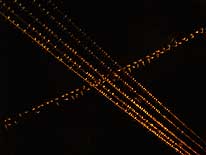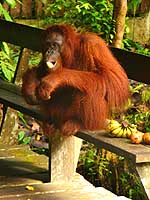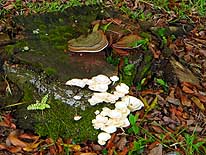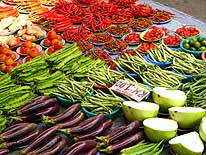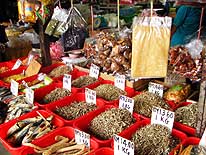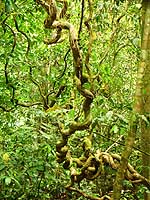- Enjoy some pictures of the worldrecordtour, taken in Sarawak,
- the East Malaysian Province on Borneo - Part 2: South (Kuching)
|
||||
Sarawak
|
Malaysia
|
|||
More websites from Borneo:
|
||||
|
|
|
||
|
|
|
||
| Sarawak - "Land of the Hornbill" – "KUCHING" (Part 2)
|
||||
|
|
|
||
| To puzzle now our brains over it and to be upset does not help much. It is more important to make a decision right away: Shall we pack these two still working parts on our already overloaded roof rack? Does it make any sense to carry around such bulky, heavy pieces? Or shall we forget about heating in full optimism that we shall find a solution once we should travel in cooler regions? Or shall we accept Mr. Lau’s time-consuming proposal to modify the missing device, whereas the whole dash board with the chaotic electric wiring would have to be disconnected again – not really what we are looking forward to. After many discussions and not happy, we finally opt for the momentarily easiest way out: To leave the stuff behind in Miri. “What do we owe you”, we ask Mr. Lau after all the adjustments are completed. “No need” he replies. Instead, he invites us to a lovely farewell lunch together with his mechanics to a cozy Malaysian garden restaurant. The selection of delicious food – crispy pork (a bit fat though), chicken and vegetables – and plenty of Tiger draft beer lets us soon forget our incident from the morning and we toast to the finally still very successful completion of our rejuvenation adventure.
|
||||
|
|
|
||
| Mid morning of October 24th, we definitely leave Miri and start our journey southwards. It is a holiday – “Hari Raya Aidilfitri”, marking the end of Ramadan, the holy Moslem fasting month. Therefore, many big families take also the chance to visit the famous Niah-Caves. Arriving at the visitor center, we first cross the narrow Niah jungle river in a small boat, and then start our two miles hike on a rotten elevated wooden walkway through lowland woods to the caves, hidden in the jungle. Along our way, we always discover new wonders of the fascinating tropical rain forest world: Artfully twisted branches are hanging from the trees, colorful butterflies are fluttering around the swampy areas, red cup fungus are growing on dead trunks and red centipedes crawl on the wooden handrails, preventing us to use them. 40’000 years ago, the caves were populated by prehistoric men. Now, they are home to the bats which deposit their droppings or guano on the cave floor – a rich source of fertilizer – and thousands of swiftlets, which build edible nests high up in the cave’s ceiling, which are greatly favored by the Chinese as the basic of a culinary treat – the bird nest soup. They are sold for US$500 a pound (for one pound of good, clean quality it needs 14 - 18 nests). We therefore can understand the temptation of the many licensed local collectors, who climb the tall, from the top hanging “Belian”, a “ladder” high up the cave’s ceiling, made of massive bamboo poles, tied together. What is there so exceptional about these bird nests? It is the dried spit, which is obtained by soaking the nests in water in order to remove feathers and impurities. One bowl of soup can easily shrink a wallet: It costsUS$45 for a reasonable and US$65 for a top quality. There might therefore be a bit of truth in the rumors that some people broadcast bird calls through loud speakers to attract passing birds, hoping that they nest in their window and house niches – which no doubt can result in a profitable business.
|
||||
|
|
|
||
| In the early afternoon, these “treasure-bringers” are still searching for food, and we take our time exploring the Great Cave with their mostly red-green-white colored and bizarre shaped stalagmites and stalactites. Some of them look unreal – like a painted fairytale landscape. But the most beautiful surprise is when a sudden heavy downpour outside of the cave produces a wonderful waterfall inside. We cannot stop keeping our eyes from this amazing sight. Only the approaching evening – when the soft calls of the swiftlets announce their return – pushes us to begin our long hike back on the boardwalk, which due to the rain became dangerously slippery. Spontaneously, we decide to spend the night in the National Park compound and fall asleep with a noisy performance of hundreds of frogs and toads. Next morning, we continue to follow the lonely coastal road towards the South. We cannot waive our thoughts from the family from Brunei who recently got attacked and robbed on the same stretch. Another car slammed into the rear of their vehicle, and when they got out to check the damage, masked men showed up and robbed all their possessions, including their automobile. Without having paranoia, this incidence still crosses our mind, while we are driving through huge freshly cleared rain forest, where the slashed and burnt trunks raise up towards the sky as a reminder of the continuous and disastrous exploitation of nature – only because palmoil plantations bring more money. It is a lovely change when we spot shortly afterwards many wild lilac orchids on the road side, growing on long grassy stems. We encounter entire meadows of them, especially when we leave the main road near the modern port of Bintulu towards the Similajau coastal National Park.
|
||||
|
|
|
||
| People are still celebrating, when we arrive at the beach. Boys dance happily by themselves, families take a picnic on mats spread out in the sand – today is the second holiday of “Hari Raya Aidilfitri”. But mid-afternoon, when all start to return to their homes, peace becomes wonderfully restored again. In the cool breeze of the evening, we stroll along the beach that is covered with scattered old tree trunks and fallen leaves, but unfortunately no shells enjoy my eyes! Where the river meets the sea, we are abruptly stopped by warning signs that salt water crocodiles live in these waters, which does not really encourage us to continue any further. (Later in the evening, we read in our LonelyPlanet guidebook that back in 2002 three locals have been eaten on this spot). We return and enjoy the evening hours further away. Far out in the sea, magnificent cloud formations are piling high up. The setting sun colors them from yellowish to orange to red. Sitting on a tree trunk, we admire this unique spectacle of nature until the darkness surrounds us entirely. Simultaneously the flames of the nearby oil refinery in Bintulu reflect brilliantly in the water.
|
||||
|
|
|
||
| Already two days later, we are on the move again towards Sibu, the next big town southwards. On our way, we have to cross many small bridges, where without exception we are required to slow down fully due to the high bumps before and after the bridges. But this allows us to get a glimpse of the many small dark jungle rivers criss-crossing Sarawak. All of them look in a way mysterious – a bit an intact world in comparison to the vast navigable rivers, where pile after pile of precious trees are accumulated to be transported or processed in one of the wood factories. Sibu welcomes us with a heavy tropical downpour, paralyzing the entire traffic for more than an hour. But once the skiy clears up again, the city along the Rajang-River is revealing its particular charm with riverboats arriving and departing, but also with the 100-year old Chinese “Tua Pek Kong”-Temple with its 7-storied “Kuan Vin”-Pagoda. The caretaker obligingly gives us – against a small donation – the key for the tower, from where we are able to enjoy a magnificent view. It is obvious that there are more churches here than in the North, where mosques dominate. It is also obvious that the Chinese population has noticeably increased here. Road signs are now found trilingual: In Malay, Chinese and in English.
|
||||
|
|
|
||
| A detour of only 44 miles brings us to Sarikei, like Sibu situated at the banks of the brownish-reddish Rajang-River. From the very moment we arrive, luck is with us. It is a peaceful Sunday afternoon and the small river promenade with its stone benches is almost deserted. It is a lovely place to relax and admire the old warehouses facing the waterfront and the adventurous looking small river boats sailing to remote jungle settlements. Each time when such a ship appears out of a narrow river tributary opposite of the port, our thoughts start to roam: From which forgotten place is it coming from? How might it look there? People who arrive are unloading mostly vegetables for the market. People who are boarding carry bursting full bags with all kind of necessities for their daily life. Memories come alive of our trip in April 1988 on the mighty Amazon-River from Manaus to Porto Velho in Brazil, where we could load our LandCruiser on an empty bridge of a truck, which allowed us to discover the rainforest while passing by with all its life, noises and secrets – day and night during five full days. For a brief moment, we are tempted to repeat such a river trip into the interior right here, but dismiss the idea shortly after, because this time, we would have to leave behind our LandCruiser – an idea we are not comfortable with. Too much we enjoy the comfort it provides to us; and who guarantees us that we will find it still safe at our return? When the sun sets behind the rain forest canopy, we return to the city center and plunge into a new experience right away:
|
||||
|
|
|
||
| In the middle of the traffic noise and the glittering lights, thousands of swiftlets have settled side by side for the night on the power lines in the city center. Their white breasts are reflecting in the street lights. And still more and more late-comers try to squeeze-in in the already overcrowded rows – mostly without any success though. We ask the caretaker of the Methodist Church, who kindly offered us against a small appreciation a comfortable guest room and a secure parking space behind walls, what makes these birds come into the noisy town. He does not have an answer either, but tells us that this is nothing compared with the peak season in December. “Then the whole place will be covered with droppings”, he adds. When we proceed next morning towards Kuching, the weather has changed. Strong winds come up and blow – as earlier in Sabah too – haze of smoke from neighboring Indonesia’s illegal burnings and from own Malaysian forest fires all over the planes, hiding everything in a grey smog. Nevertheless we decide to make another small detour, this time to Sri Aman. It turns out to be not the best idea; it does not bring us any luck at all. Firstly, the view is so bad, that we can hardly see across the river. Secondly, the spectacle of the tidal bore that periodically sweeps up the river if high tide is coming in, does not take place on the time announced at the notice board, and thirdly, we get troubles with a young girl on a motorbike, when we stop and want to reverse into an empty parking lot. While backing up one yard, we hear a bang and the noise of breaking plastic behind us. Checking the situation, a distracted young lady on a lilac moped is looking at us – the front fender of her motorbike being broken. Luckily she remained unhurt. It is unfortunate, but has happened only because the girl has closed up too much and exactly in the middle, where due to the dead angle it was impossible for Emil to see her. Luckily we are insured, we think.
|
||||
|
|
|
||
| But to make the insurance paying, we need a police report what we try to explain to the girl who does not understand any English. She quickly takes her cell-phone and talks with her mother, who appears soon after on the scene. At least, now we can communicate a bit. We decide that the four of us will go to the police station and offer the lady to join us in our car. Of course, at the police station we encounter the same situation: Nobody speaks English. We have to wait until the boss is mobilized. He explains us that each report costs Ringgit 300 (approx. US$ 80). “How much will the repair cost”, we ask. While we argue with the police about the responsibility of the accident, the girl drives away to consult her uncle, who owns a work shop. As she tells us that the amount will be only Ringgit 80, we are quite relieved and readily agree to settle the matter on the spot. The girl has to pay 30 Ringgit – as a lesson for stopping too close behind us – and we pay the rest. More than happy about the soft ending, we shake hands. After that, nothing can keep us back anymore in Sri Aman, and in the evening, Sarawak’s capital Kuching is already greeting us.
|
||||
|
|
|
||
| Kuching, what in Malay means “cat”, is nestled on the banks of the Sarawak-River. The many modern high-rise hotel buildings lining the waterfront do not evoke “love at first sight” feelings. But thanks to the location of our good – though very noisy – accommodation, we are going to like it each day more. In the diocese of the St. Thomas Cathedral, we find an airy room with four beds, toilet, shower and a functioning kitchen with a gas stove. And very soon, Emil discovers that on our wooden verandah, we are able to receive wireless internet from a nearby internet cafe. The price of Ringgit 30 per day (US$8) is fine for us, our LandCruiser is parked safely in front of the house, and on foot, we are within minutes at the waterfront, the main bazaar, in the heart of old Kuching, in the pedestrian area, the Sarawak Museum and in the modern part with the supermarkets. Ironically, what we disliked at the beginning becomes our favorite spot, especially towards the evening, when the setting sun transforms everything with its warm light. It is the half mile long river promenade, where the views across the river to Fort Margherita and the Astana, the official residence of the governor of Sarawak, are especially beautiful. It is also the time and place where people meet. Surprisingly, many groups of youngsters stroll along the river and we notice also the presence of the normally discreet police. But it happens more than once that they stop the youngsters and search them thoroughly. They must have a reason, we guess! An old man with a long grey beard is sitting always on the same bench, where also “Gambir” is sold – an extract made of leaves and barks of the rainforest, supposed to have healing effects. One day, he starts to talk to us and tells us his whole life story. He is originating from Hamburg/Germany and apparently was running two prosperous bars in town. But now, he is bankrupt. One day, his local partner, who owned 51% of the business, run away with all the money. His wife, he carries on, died of cancer in Germany at the age of 42. It is not the first time on our journey that we hear stories like this one and are therefore a bit skeptical. For a good reason: At the end he asks us for money. We deny, because we never had and will never have any comprehension and compassion with people of our culture begging in a foreign country.
|
||||
|
|
|
||
| When we look for the Indonesian Consulate, a thunderstorm is passing over the city. We hope to finally get the permit to enter Indonesia with our own car over the nearby land border (after more than six months of haggling and a lot of patience). It was issued by Interpol Jakarta and sent to the Indonesian Embassy in Kuala Lumpur to be forwarded to the Indonesian Consulate in Kuching. After explaining in a separate note addressed to the Consul about the purpose of our visit, we are asked to wait. We wait and wait for about four hours, until we suddenly are called up and told that they want to check the engine and chassis number of our LandCruiser. Instantly we knew that we made it! We are overwhelmed with joy and do not care that we have to pay 60 Ringgit for this precious paper. As entry date, we fixed November 15th. Today is November 1st, giving us still plenty of time to explore more of Southern Sarawak.
|
||||
|
|
|
||
| Coincidentally, we enter the Tourist Information office to get an accurate city map just when a new note is posted, which says in big letters that currently two Rafflesia flowers – the biggest and one of the rarest flower in the world – are blooming at the Gunung Gading National Park. We are really thrilled about this news, because we missed this sight on our previous trip in Sabah. One flower is said to have a diameter of 30 inches and is expected to bloom until November 11th; the smaller one measures 18 inches and will live until November 8th, only. Being already the 6th, we do not want to loose any time and therefore we are already on our way to the National Park next morning. The more we leave the town behind us, the more rural and beautiful the landscape gets. The sun is shining and we are just happy to be on the road to an exciting destination. At the village of Bau, we miss a right turn, what we only realize when we read road signs with names of places that are close to or after the Indonesian border. On the second checkpoint, the two policemen give us directions to get us to the right track again and we turn around. These three miles were he nicest of today’s trip. The rainforest is still untouched and deeply forested outcrops tower against an unusual blue sky. Unfortunately, this lovely scenery changes abruptly when we drive towards Lundu and the National Park. It gets drier and dustier.
|
||||
|
|
|
||
| Shortly after noon, we arrive at the National Park visitor center bordering peacefully the mountainous forest. Two elderly French couples just return with a ranger from their Rafflesia tour. Probably he might not been so keen to repeat the trip so soon again. When we read on the notice board that the blooming flowers are only 20 minutes away and close to the walkway, we ask the friendly lady warden if we can go without a guide. Surprisingly, she goes to her computer and prints immediately a map for us. With two black dots she marks the spots where we have to look for. Well, now it is getting really exciting. It is like on a “paper chase” game we used to play as kids. Who reaches the goal first? Suddenly, Emil shouts in his unemotional way: “Come here!” Actually, I am not really surprised that he is the winner. He always had a special nose and the logical thinking abut things like this. It is the smaller one he discovered first. It is lying like a cabbage (this is how they look apparently before being in bloom) near a rotten trunk on the moist forest soil and is shining deeply red. Although we have seen its picture many times on leaflets and postcards, we are amazed about the size, beauty and uniqueness. The second and bigger Rafflesia is even more impressive and its red color is more intense. Astonishingly, this leafless flower takes 15 months to grow, but then it dies after 4-5 days of blooming only. Just besides of it, we see a funny shaped grayish-brown termite nest, similar to udders of cows; and then green “cherries” growing directly out of a tree trunk – the same we saw in Hong Kong –, and a multitude of climbing plants, creepers and Bromeliads. For us, the natural jungle is always fascinating and never tiring in its diversity of plants and life. The time has been flying. It is already mid-afternoon, leaving us little time to eat a small snack at the nearby Siar beach before backtracking the 60 miles to Kuching.
|
||||
|
|
|
||
| Only 20 miles from the capital, the Cultural Village in Damai is another attraction, displaying Sarawak’s many cultures. The replicas of seven ethnic houses are grouped around a man-made lake on a forested foothill. In the early afternoon hours, we have this living museum all to ourselves, as we walk through an adventurous bridge made entirely of bamboo poles towards the first longhouse – the one of the Bidayuh people. Girls and boys of this ethnic group welcome us in their traditional dresses. They are soft natured, very friendly and eager to show us around their home. We are especially impressed by the spaciousness, suitableness and simplicity, but also of the coolness it provides. Adjacent is a simple hut made of straw, which is used as a community hall and from where suddenly the beat of drums reaches our ears. We step in just in time to assist at a colorful dance performed by lovely dressed young girls. Of course, we know that this is their job and that they get paid for it. But still, it is an enjoyable moment. A similar situation presents us at the longhouse of the Iban tribe, known as the notorious and legendary warriors and headhunters of Borneo (2/3 of Sarawakians are Ibans). Here, two ladies show us the art of weaving. We watch how they add with skilled hands golden threads into the tissue. Another lady is baking rice pancakes and sells them for one Ringgit each. There is such a promising smell in the air that we cannot resist to buy some too. They taste delicious!
|
||||
|
|
|
||
|
||||
|
|
|
||
| Next morning, we are very excited to have – after Sabah – our second encounter with Orang Utan, the highly endangered big apes. Only 12 miles out of town is the Semenggoh Nature Reserve with the Orang Utan Rehabilitation Center, where currently 22 of these adorable creatures are taken care of affectionately, and trained for a life in freedom. Already on our arrival at 8.30am, an adult female is sitting on a wooden bench stuffing one ripe banana after the other into her mouth. She does not take any notice of our presence – she is used to humans, because she is raised and trained by them. All of the Orang Utan in this center are either orphans or have been rescued from their sad existence as chained domestic animals. All of a sudden, some movement is coming into the scene: The heavy primate – it can weigh up to 450 pounds and grow up to 5 ft. – gets up and moves slowly in our direction – no worries, we automatically retreat at the sight of this strong and hairy creature! It lifts the cover of the next garbage bin, catches an empty bottle of Borneo mineral water and opens cleverly the screw cap. What blocks the neck of the bottle? First, it tries to clear it with a finger, and when it does not work, gets frustrated and impatiently tries with banging it. Did these monkeys copy it from humans or are they so intelligent? On the wide branches high above our heads, two babies are playing joyfully. It is absolutely adorable to watch them, and we do not dare thinking what could have happened, if this rehabilitation center would have been shut down. The mere thought of it breaks our hearts. Apparently, the Sarawakian Tourist Office could finally stop the disastrous decision in the last minute.
|
||||
|
|
|
||
|
||||
|
|
|
||
|
||||
|
|
|
||
|
||||
|
|
|
||
More websites from East Malaysia and Brunei:
|
||||
|
||||









